Deck 2: Modeling Data in the Organization
Question
Question
Question
Question
Question
Question
Question
Question
Question
Question
Question
Question
Question
Question
Question
Question
Question
Question
Question
Question
Question
Question
Question
Question
Question
Question
Question
Question
Question
Question
Question
Question
Question
Question
Question
Question
Question
Question
Question
Question
Question
Question
Question
Question
Question
Question
Question
Question
Question
Question
Question
Question
Question
Question
Question
Question
Question
Question
Question
Question
Question
Question
Question
Question
Question
Question
Question
Question
Question
Question
Question
Question
Question
Question
Question
Question
Question
Question
Question
Question

Unlock Deck
Sign up to unlock the cards in this deck!
Unlock Deck
Unlock Deck
1/103
Play
Full screen (f)
Deck 2: Modeling Data in the Organization
1
Business policies and rules govern all of the following EXCEPT:
A) managing employees.
B) creating data.
C) updating data.
D) removing data.
A) managing employees.
B) creating data.
C) updating data.
D) removing data.
A
2
A person's name, birthday, and social security number are all examples of:
A) attributes.
B) entities.
C) relationships.
D) descriptors.
A) attributes.
B) entities.
C) relationships.
D) descriptors.
A
3
An entity type whose existence depends on another entity type is called a ________ entity.
A) strong
B) weak
C) codependent
D) variant
A) strong
B) weak
C) codependent
D) variant
B
4
The logical representation of an organization's data is called a(n):
A) database model.
B) entity-relationship model.
C) relationship systems design.
D) database entity diagram.
A) database model.
B) entity-relationship model.
C) relationship systems design.
D) database entity diagram.

Unlock Deck
Unlock for access to all 103 flashcards in this deck.
Unlock Deck
k this deck
5
A property or characteristic of an entity type that is of interest to the organization is called a(n):
A) attribute.
B) coexisting entity.
C) relationship.
D) cross-function.
A) attribute.
B) coexisting entity.
C) relationship.
D) cross-function.

Unlock Deck
Unlock for access to all 103 flashcards in this deck.
Unlock Deck
k this deck
6
A(n) ________ is the relationship between a weak entity type and its owner.
A) member chain
B) identifying relationship
C) jump path
D) chain link
A) member chain
B) identifying relationship
C) jump path
D) chain link

Unlock Deck
Unlock for access to all 103 flashcards in this deck.
Unlock Deck
k this deck
7
Data modeling may be the most important part of the systems development process because:
A) data characteristics are important in the design of programs and other systems components.
B) the data in a system are generally less complex than processes and play a central role in development.
C) data are less stable than processes.
D) it is the easiest.
A) data characteristics are important in the design of programs and other systems components.
B) the data in a system are generally less complex than processes and play a central role in development.
C) data are less stable than processes.
D) it is the easiest.

Unlock Deck
Unlock for access to all 103 flashcards in this deck.
Unlock Deck
k this deck
8
An attribute that must have a value for every entity (or relationship) instance is a(n):
A) composite attribute.
B) required attribute.
C) optional attribute.
D) multivalued attribute.
A) composite attribute.
B) required attribute.
C) optional attribute.
D) multivalued attribute.

Unlock Deck
Unlock for access to all 103 flashcards in this deck.
Unlock Deck
k this deck
9
A good data definition will describe all of the characteristics of a data object EXCEPT:
A) subtleties.
B) examples.
C) who determines the value of the data.
D) who can delete the data.
A) subtleties.
B) examples.
C) who determines the value of the data.
D) who can delete the data.

Unlock Deck
Unlock for access to all 103 flashcards in this deck.
Unlock Deck
k this deck
10
An attribute of an entity that must have a value for each entity instance is a(n):
A) optional attribute.
B) composite attribute.
C) required attribute.
D) fuzzy attribute.
A) optional attribute.
B) composite attribute.
C) required attribute.
D) fuzzy attribute.

Unlock Deck
Unlock for access to all 103 flashcards in this deck.
Unlock Deck
k this deck
11
The most common types of entities are:
A) strong entities.
B) weak entities.
C) associative entities.
D) smush entities.
A) strong entities.
B) weak entities.
C) associative entities.
D) smush entities.

Unlock Deck
Unlock for access to all 103 flashcards in this deck.
Unlock Deck
k this deck
12
Which of the following is an entity that exists independently of other entity types?
A) Codependent
B) Weak
C) Strong
D) Variant
A) Codependent
B) Weak
C) Strong
D) Variant

Unlock Deck
Unlock for access to all 103 flashcards in this deck.
Unlock Deck
k this deck
13
Customers, cars, and parts are examples of:
A) entities.
B) attributes.
C) cardinals.
D) relationships.
A) entities.
B) attributes.
C) cardinals.
D) relationships.

Unlock Deck
Unlock for access to all 103 flashcards in this deck.
Unlock Deck
k this deck
14
An entity type name should be all of the following EXCEPT:
A) concise.
B) specific to the organization.
C) as short as possible.
D) a singular noun.
A) concise.
B) specific to the organization.
C) as short as possible.
D) a singular noun.

Unlock Deck
Unlock for access to all 103 flashcards in this deck.
Unlock Deck
k this deck
15
A ________ defines or constrains some aspect of the business.
A) business constraint
B) business structure
C) business control
D) business rule
A) business constraint
B) business structure
C) business control
D) business rule

Unlock Deck
Unlock for access to all 103 flashcards in this deck.
Unlock Deck
k this deck
16
Which of the following is NOT a good characteristic of a data name?
A) Relates to business characteristics
B) Readable
C) Repeatable
D) Relates to a technical characteristic of the system
A) Relates to business characteristics
B) Readable
C) Repeatable
D) Relates to a technical characteristic of the system

Unlock Deck
Unlock for access to all 103 flashcards in this deck.
Unlock Deck
k this deck
17
A fact is an association between two or more:
A) words.
B) terms.
C) facts.
D) nuggets.
A) words.
B) terms.
C) facts.
D) nuggets.

Unlock Deck
Unlock for access to all 103 flashcards in this deck.
Unlock Deck
k this deck
18
Which of the following is NOT a characteristic of a good business rule?
A) Declarative
B) Atomic
C) Inconsistent
D) Expressible
A) Declarative
B) Atomic
C) Inconsistent
D) Expressible

Unlock Deck
Unlock for access to all 103 flashcards in this deck.
Unlock Deck
k this deck
19
In an E-R diagram, there are/is ________ business rule(s) for every relationship.
A) two
B) three
C) one
D) zero
A) two
B) three
C) one
D) zero

Unlock Deck
Unlock for access to all 103 flashcards in this deck.
Unlock Deck
k this deck
20
The following figure shows an example of: 
A) a one-to-many relationship.
B) a strong entity and its associated weak entity.
C) a co-dependent relationship.
D) a double-walled relationship.

A) a one-to-many relationship.
B) a strong entity and its associated weak entity.
C) a co-dependent relationship.
D) a double-walled relationship.

Unlock Deck
Unlock for access to all 103 flashcards in this deck.
Unlock Deck
k this deck
21
Which of the following criteria should be considered when selecting an identifier?
A) Choose an identifier that is not stable.
B) Choose a null identifier.
C) Choose an identifier that doesn't have large composite attributes.
D) Choose the most complex identifier possible.
A) Choose an identifier that is not stable.
B) Choose a null identifier.
C) Choose an identifier that doesn't have large composite attributes.
D) Choose the most complex identifier possible.

Unlock Deck
Unlock for access to all 103 flashcards in this deck.
Unlock Deck
k this deck
22
A ________ specifies the number of instances of one entity that can be associated with each instance of another entity.
A) degree
B) cardinality constraint
C) counter constraint
D) limit
A) degree
B) cardinality constraint
C) counter constraint
D) limit

Unlock Deck
Unlock for access to all 103 flashcards in this deck.
Unlock Deck
k this deck
23
The number of entity types that participate in a relationship is called the:
A) number.
B) identifying characteristic.
C) degree.
D) counter.
A) number.
B) identifying characteristic.
C) degree.
D) counter.

Unlock Deck
Unlock for access to all 103 flashcards in this deck.
Unlock Deck
k this deck
24
The following figure shows an example of: 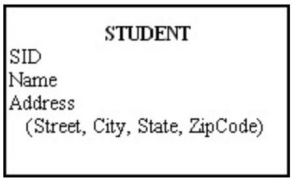
A) a composite attribute.
B) a relational attribute.
C) a derived attribute.
D) a multivalued attribute.

A) a composite attribute.
B) a relational attribute.
C) a derived attribute.
D) a multivalued attribute.

Unlock Deck
Unlock for access to all 103 flashcards in this deck.
Unlock Deck
k this deck
25
A mutually exclusive relationship is one in which:
A) an entity instance can participate in many different relationships.
B) an entity instance can participate in only one of several alternative relationships.
C) an entity instance cannot participate in a relationship with another entity instance.
D) an entity instance bridges other XML documents.
A) an entity instance can participate in many different relationships.
B) an entity instance can participate in only one of several alternative relationships.
C) an entity instance cannot participate in a relationship with another entity instance.
D) an entity instance bridges other XML documents.

Unlock Deck
Unlock for access to all 103 flashcards in this deck.
Unlock Deck
k this deck
26
A relationship between the instances of a single entity type is called a ________ relationship.
A) ternary
B) primary
C) binary
D) unary
A) ternary
B) primary
C) binary
D) unary

Unlock Deck
Unlock for access to all 103 flashcards in this deck.
Unlock Deck
k this deck
27
An entity that associates the instances of one or more entity types and contains attributes specific to the relationships is called a(n):
A) associative entity.
B) build entity.
C) gateway entity.
D) smush entity.
A) associative entity.
B) build entity.
C) gateway entity.
D) smush entity.

Unlock Deck
Unlock for access to all 103 flashcards in this deck.
Unlock Deck
k this deck
28
An attribute that can be broken down into smaller parts is called a(n) ________ attribute.
A) associative
B) simple
C) composite
D) complex
A) associative
B) simple
C) composite
D) complex

Unlock Deck
Unlock for access to all 103 flashcards in this deck.
Unlock Deck
k this deck
29
An attribute that uniquely identifies an entity and consists of a composite attribute is called a(n):
A) composite attribute.
B) composite identifier.
C) identifying attribute.
D) relationship identifier.
A) composite attribute.
B) composite identifier.
C) identifying attribute.
D) relationship identifier.

Unlock Deck
Unlock for access to all 103 flashcards in this deck.
Unlock Deck
k this deck
30
The number of entity types that participate in a Unary relationship is:
A) zero.
B) one.
C) two.
D) three.
A) zero.
B) one.
C) two.
D) three.

Unlock Deck
Unlock for access to all 103 flashcards in this deck.
Unlock Deck
k this deck
31
In the following diagram, what type of relationship is depicted? 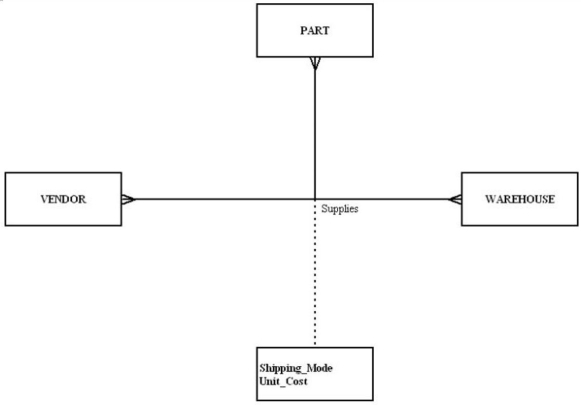
A) Unary
B) Binary
C) Ternary
D) Quad

A) Unary
B) Binary
C) Ternary
D) Quad

Unlock Deck
Unlock for access to all 103 flashcards in this deck.
Unlock Deck
k this deck
32
A relationship where the minimum and maximum cardinality are both one is a(n) ________ relationship.
A) optional
B) unidirectional
C) mandatory link
D) mandatory one
A) optional
B) unidirectional
C) mandatory link
D) mandatory one

Unlock Deck
Unlock for access to all 103 flashcards in this deck.
Unlock Deck
k this deck
33
A simultaneous relationship among the instances of three entity types is called a ________ relationship.
A) ternary
B) tertiary
C) primary
D) binary
A) ternary
B) tertiary
C) primary
D) binary

Unlock Deck
Unlock for access to all 103 flashcards in this deck.
Unlock Deck
k this deck
34
In the figure below, which attribute is multivalued? 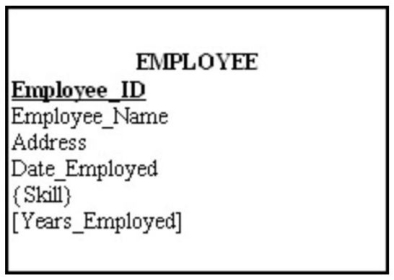
A) Years_Employed
B) Employee_ID
C) Skill
D) Address

A) Years_Employed
B) Employee_ID
C) Skill
D) Address

Unlock Deck
Unlock for access to all 103 flashcards in this deck.
Unlock Deck
k this deck
35
An attribute that can be calculated from related attribute values is called a ________ attribute.
A) simple
B) composite
C) multivalued
D) derived
A) simple
B) composite
C) multivalued
D) derived

Unlock Deck
Unlock for access to all 103 flashcards in this deck.
Unlock Deck
k this deck
36
For the relationship represented in the figure below, which of the following is true? 
A) An employee can work in more than one department but does not have to work for any department.
B) A department must have at least one employee.
C) A department can have more than one employee.
D) An employee has to work for more than one department.

A) An employee can work in more than one department but does not have to work for any department.
B) A department must have at least one employee.
C) A department can have more than one employee.
D) An employee has to work for more than one department.

Unlock Deck
Unlock for access to all 103 flashcards in this deck.
Unlock Deck
k this deck
37
In the figure below, which attribute is derived? 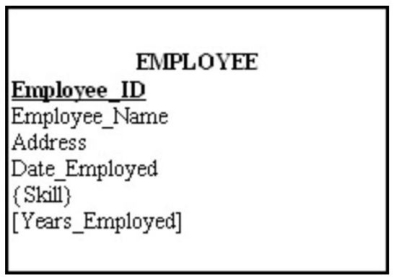
A) Years_Employed
B) Employee_ID
C) Skill
D) Address

A) Years_Employed
B) Employee_ID
C) Skill
D) Address

Unlock Deck
Unlock for access to all 103 flashcards in this deck.
Unlock Deck
k this deck
38
In the figure shown below, which of the following is true? 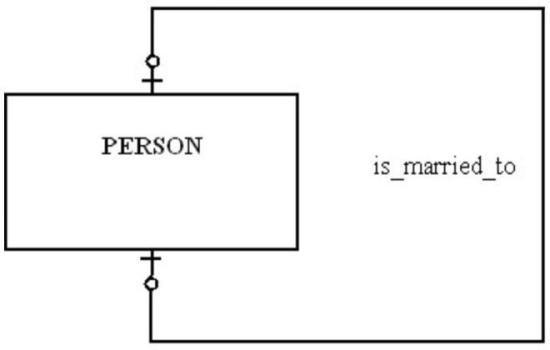
A) A person can marry at most one person.
B) A person has to be married.
C) A person can marry more than one person, but that person can only be married to one person.
D) A person can marry more than one person.

A) A person can marry at most one person.
B) A person has to be married.
C) A person can marry more than one person, but that person can only be married to one person.
D) A person can marry more than one person.

Unlock Deck
Unlock for access to all 103 flashcards in this deck.
Unlock Deck
k this deck
39
The total quiz points for a student for an entire semester is a(n) ________ attribute.
A) derived
B) mixed
C) stored
D) addressed
A) derived
B) mixed
C) stored
D) addressed

Unlock Deck
Unlock for access to all 103 flashcards in this deck.
Unlock Deck
k this deck
40
In the following diagram, which is true? 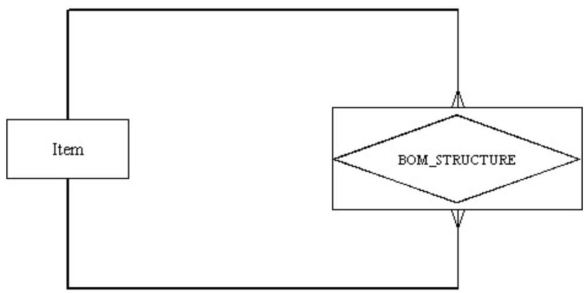
A) It depicts a ternary relationship.
B) It depicts a many-to-many relationship.
C) Item represents a column.
D) BOM_STRUCTURE represents a row.

A) It depicts a ternary relationship.
B) It depicts a many-to-many relationship.
C) Item represents a column.
D) BOM_STRUCTURE represents a row.

Unlock Deck
Unlock for access to all 103 flashcards in this deck.
Unlock Deck
k this deck
41
A business rule is a statement that defines or constrains some aspect of the business.

Unlock Deck
Unlock for access to all 103 flashcards in this deck.
Unlock Deck
k this deck
42
In the figure shown below, which of the following business rules would apply? 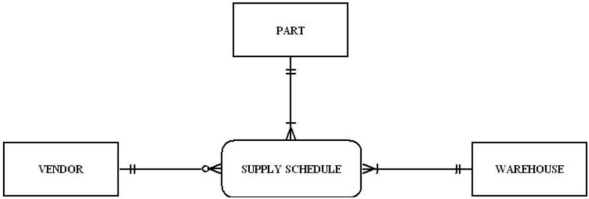
A) Each vendor can supply many parts to any number of warehouses, but need not supply any parts.
B) Each part must be supplied by exactly one vendor to any number of warehouses.
C) Each warehouse can be supplied with any number of parts from more than one vendor, and each warehouse could be supplied with no parts.
D) VENDOR is not allowed.

A) Each vendor can supply many parts to any number of warehouses, but need not supply any parts.
B) Each part must be supplied by exactly one vendor to any number of warehouses.
C) Each warehouse can be supplied with any number of parts from more than one vendor, and each warehouse could be supplied with no parts.
D) VENDOR is not allowed.

Unlock Deck
Unlock for access to all 103 flashcards in this deck.
Unlock Deck
k this deck
43
A business rule is a statement of how a policy is enforced or conducted.

Unlock Deck
Unlock for access to all 103 flashcards in this deck.
Unlock Deck
k this deck
44
The intent of a business rule is to break down business structure.

Unlock Deck
Unlock for access to all 103 flashcards in this deck.
Unlock Deck
k this deck
45
While business rules are not redundant, a business rule can refer to another business rule.

Unlock Deck
Unlock for access to all 103 flashcards in this deck.
Unlock Deck
k this deck
46
An example of a term would be the following sentence: "A student registers for a course."

Unlock Deck
Unlock for access to all 103 flashcards in this deck.
Unlock Deck
k this deck
47
One of the roles of a database analyst is to identify and understand rules that govern data.

Unlock Deck
Unlock for access to all 103 flashcards in this deck.
Unlock Deck
k this deck
48
An entity is a person, place, object, event, or concept in the user environment about which the organization wishes to maintain data.

Unlock Deck
Unlock for access to all 103 flashcards in this deck.
Unlock Deck
k this deck
49
Enforcement of business rules can be automated through the use of software tools that can interpret the rules and enforce them.

Unlock Deck
Unlock for access to all 103 flashcards in this deck.
Unlock Deck
k this deck
50
A business rule should be internally consistent.

Unlock Deck
Unlock for access to all 103 flashcards in this deck.
Unlock Deck
k this deck
51
Business rules are formulated from a collection of business ramblings.

Unlock Deck
Unlock for access to all 103 flashcards in this deck.
Unlock Deck
k this deck
52
In the following diagram, which of the answers below is true? 
A) Each patient has one or more patient histories.
B) Each patient has one and only one visit.
C) Each patient history belongs to zero and one patient.
D) Each patient history belongs to many patients.

A) Each patient has one or more patient histories.
B) Each patient has one and only one visit.
C) Each patient history belongs to zero and one patient.
D) Each patient history belongs to many patients.

Unlock Deck
Unlock for access to all 103 flashcards in this deck.
Unlock Deck
k this deck
53
Data names should always relate to business characteristics.

Unlock Deck
Unlock for access to all 103 flashcards in this deck.
Unlock Deck
k this deck
54
A fact is an association between two or more terms.

Unlock Deck
Unlock for access to all 103 flashcards in this deck.
Unlock Deck
k this deck
55
A value that indicates the date or time of a data value is called a:
A) value stamp.
B) time stamp.
C) checkpoint.
D) check counter.
A) value stamp.
B) time stamp.
C) checkpoint.
D) check counter.

Unlock Deck
Unlock for access to all 103 flashcards in this deck.
Unlock Deck
k this deck
56
A good data definition is always accompanied by diagrams, such as the entity-relationship diagram.

Unlock Deck
Unlock for access to all 103 flashcards in this deck.
Unlock Deck
k this deck
57
The E-R model is used to construct a conceptual model.

Unlock Deck
Unlock for access to all 103 flashcards in this deck.
Unlock Deck
k this deck
58
When systems are automatically generated and maintained, quality is diminished.

Unlock Deck
Unlock for access to all 103 flashcards in this deck.
Unlock Deck
k this deck
59
In the following diagram, which answer is true? 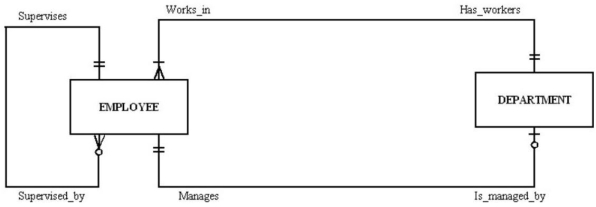
A) Each employee can supervise one employee, no employees or many employees.
B) Each employee can manage many departments.
C) Each employee works in more than one department.
D) Each employee was fired.

A) Each employee can supervise one employee, no employees or many employees.
B) Each employee can manage many departments.
C) Each employee works in more than one department.
D) Each employee was fired.

Unlock Deck
Unlock for access to all 103 flashcards in this deck.
Unlock Deck
k this deck
60
A student can attend five classes, each with a different professor. Each professor has 30 students. The relationship of students to professors is a ________ relationship.
A) one-to-one
B) many-to-many
C) one-to-many
D) strong
A) one-to-one
B) many-to-many
C) one-to-many
D) strong

Unlock Deck
Unlock for access to all 103 flashcards in this deck.
Unlock Deck
k this deck
61
A single occurrence of an entity is called an entity instance.

Unlock Deck
Unlock for access to all 103 flashcards in this deck.
Unlock Deck
k this deck
62
A simple attribute can be broken down into smaller pieces.

Unlock Deck
Unlock for access to all 103 flashcards in this deck.
Unlock Deck
k this deck
63
When choosing an identifier, choose one that will not change its value often.

Unlock Deck
Unlock for access to all 103 flashcards in this deck.
Unlock Deck
k this deck
64
Some examples of attributes are: eye_color, weight, student_id, STUDENT.

Unlock Deck
Unlock for access to all 103 flashcards in this deck.
Unlock Deck
k this deck
65
Most systems developers believe that data modeling is the least important part of the systems development process.

Unlock Deck
Unlock for access to all 103 flashcards in this deck.
Unlock Deck
k this deck
66
The purpose of data modeling is to document business rules about processes.

Unlock Deck
Unlock for access to all 103 flashcards in this deck.
Unlock Deck
k this deck
67
An attribute whose values can be calculated from related attribute values is called a derived attribute.

Unlock Deck
Unlock for access to all 103 flashcards in this deck.
Unlock Deck
k this deck
68
An entity type name should always be a singular noun.

Unlock Deck
Unlock for access to all 103 flashcards in this deck.
Unlock Deck
k this deck
69
A multivalued attribute may take on more than one value for a particular entity instance.

Unlock Deck
Unlock for access to all 103 flashcards in this deck.
Unlock Deck
k this deck
70
Participation in a relationship may be optional or mandatory.

Unlock Deck
Unlock for access to all 103 flashcards in this deck.
Unlock Deck
k this deck
71
An entity type on which a strong entity is dependent is called a covariant entity.

Unlock Deck
Unlock for access to all 103 flashcards in this deck.
Unlock Deck
k this deck
72
Data modeling is about documenting rules and policies of an organization that govern data.

Unlock Deck
Unlock for access to all 103 flashcards in this deck.
Unlock Deck
k this deck
73
Data names do not have to be unique.

Unlock Deck
Unlock for access to all 103 flashcards in this deck.
Unlock Deck
k this deck
74
The relationship between a weak entity type and its owner is an identifying relationship.

Unlock Deck
Unlock for access to all 103 flashcards in this deck.
Unlock Deck
k this deck
75
In an E-R diagram, strong entities are represented by double-walled rectangles.

Unlock Deck
Unlock for access to all 103 flashcards in this deck.
Unlock Deck
k this deck
76
In the figure below, Name would be an ideal identifier.
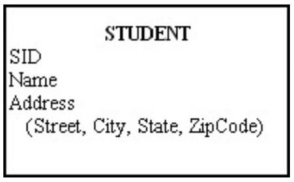


Unlock Deck
Unlock for access to all 103 flashcards in this deck.
Unlock Deck
k this deck
77
Relationships represent action being taken using a verb phrase.

Unlock Deck
Unlock for access to all 103 flashcards in this deck.
Unlock Deck
k this deck
78
The name used for an entity type should never be the same in other E-R diagrams on which the entity appears.

Unlock Deck
Unlock for access to all 103 flashcards in this deck.
Unlock Deck
k this deck
79
Data, rather than processes, are the most complex aspects of many modern information systems.

Unlock Deck
Unlock for access to all 103 flashcards in this deck.
Unlock Deck
k this deck
80
In an E-R diagram, an associative entity is represented by a rounded rectangle.

Unlock Deck
Unlock for access to all 103 flashcards in this deck.
Unlock Deck
k this deck



